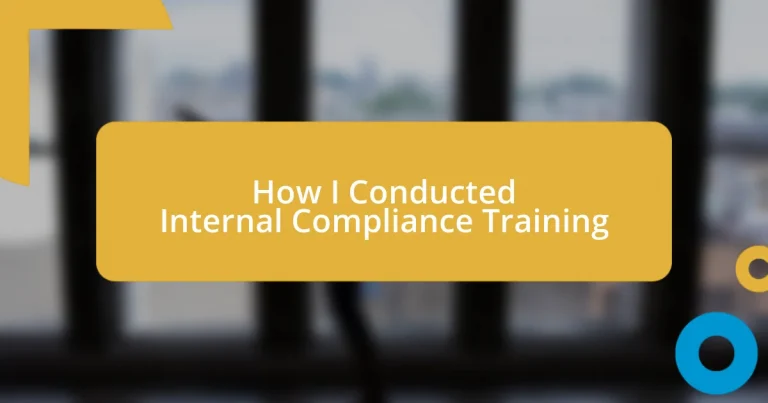Key takeaways:
- Internal compliance training fosters a culture of integrity by engaging employees through real-world scenarios and tailored discussions, encouraging personal connections to compliance.
- The training program’s effectiveness is heightened by interactive methods, such as gamification and open dialogue, leading to improved engagement and understanding among participants.
- Continuous evaluation and updating of the training program, along with ongoing support and resources, ensure its relevance and effectiveness in maintaining compliance standards.
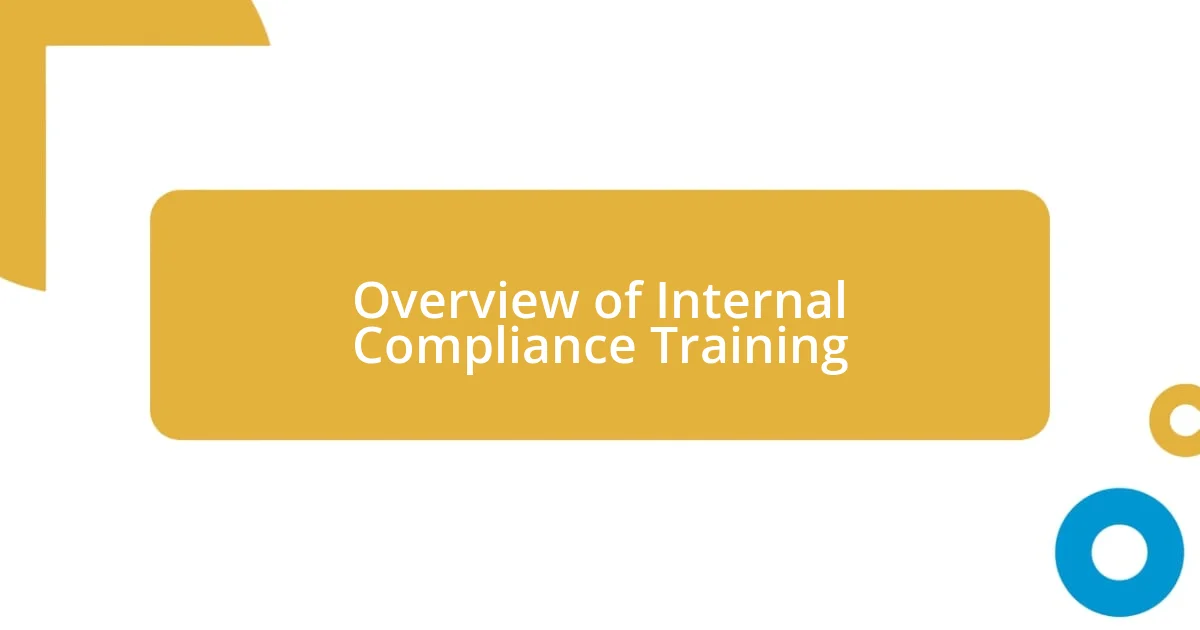
Overview of Internal Compliance Training
Internal compliance training is a vital aspect of maintaining regulatory standards within an organization. I remember the first training session I conducted; the room was filled with a mix of curiosity and anxiety. People often wonder, “Why should I care about compliance?” My experience has shown me that understanding compliance isn’t just about following the rules—it’s about fostering a culture of integrity and trust.
Throughout these sessions, I’ve focused on real-world scenarios that resonate with my colleagues. For instance, we discussed a case where a lack of compliance led to significant financial penalties for a company. Seeing the seriousness of the consequences can be a real eye-opener. It’s fascinating how such discussions transform the atmosphere; suddenly, compliance feels less like a set of abstract rules and more like a shield for our workplace’s values.
By integrating engaging activities and open discussions, I’ve observed some participants start to connect personally with the material. One question that often emerges is, “How does this apply to my role?” I’ve made it a point to tailor examples to different departments, illustrating compliance’s impact on everyone’s day-to-day responsibilities. This approach creates a more significant and lasting impression, encouraging everyone to take ownership of their role in compliance.
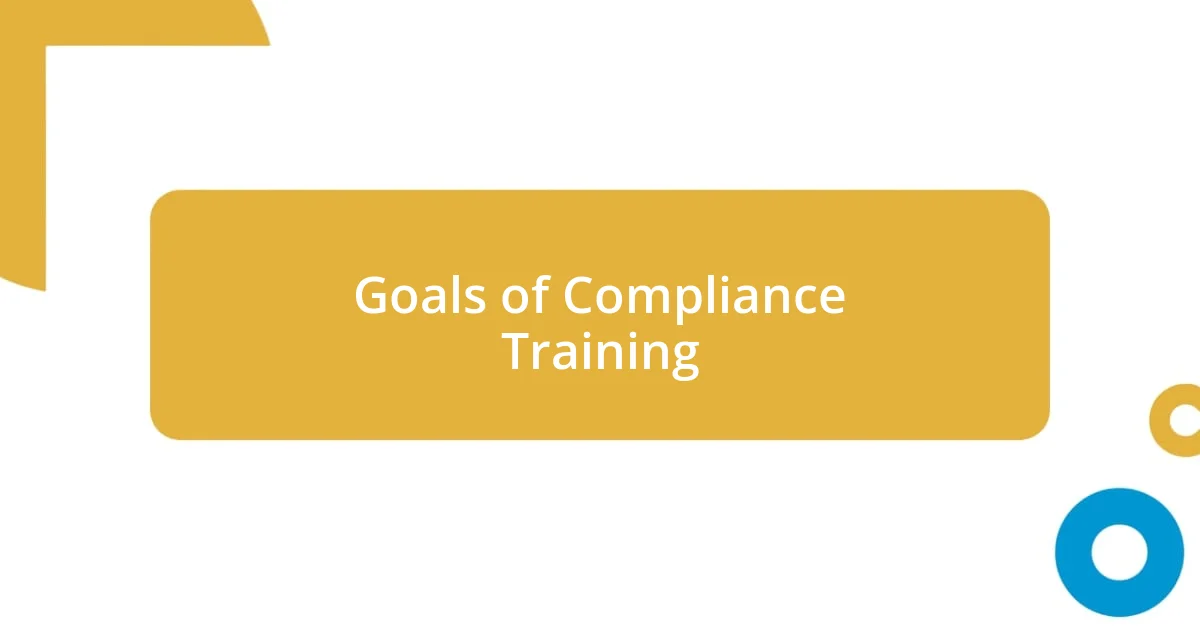
Goals of Compliance Training
The primary goal of compliance training is to ensure that all employees understand the legal and ethical standards that govern their work. I vividly recall a participant who shared how he felt overwhelmed by new regulations. After the training, he expressed a newfound clarity and confidence. This highlights that when training is effectively conducted, employees aren’t just informed—they become empowered and motivated to act within compliance guidelines.
Another essential goal is to cultivate a culture of accountability within the organization. During one session, I asked attendees to reflect on a time when they faced ethical dilemmas. The honest conversations we had were both revealing and inspiring. It demonstrated that when people feel secure discussing their challenges, they are more likely to uphold integrity in their roles, thereby reducing risks associated with non-compliance.
Lastly, compliance training aims to minimize the risks of violations that could lead to financial penalties or reputational damage. I remember a case where one company’s oversight resulted in a million-dollar fine. By sharing such concrete examples, I noticed my colleagues became more engaged, fully aware of what was at stake. This proactive approach creates a shared responsibility that ultimately safeguards the organization and its values.
| Goal | Description |
|---|---|
| Understanding Standards | Help employees grasp legal and ethical requirements. |
| Cultivating Accountability | Encourage a culture where ethical discussions are welcomed. |
| Minimizing Risks | Reduce chances of regulatory violations and penalties. |
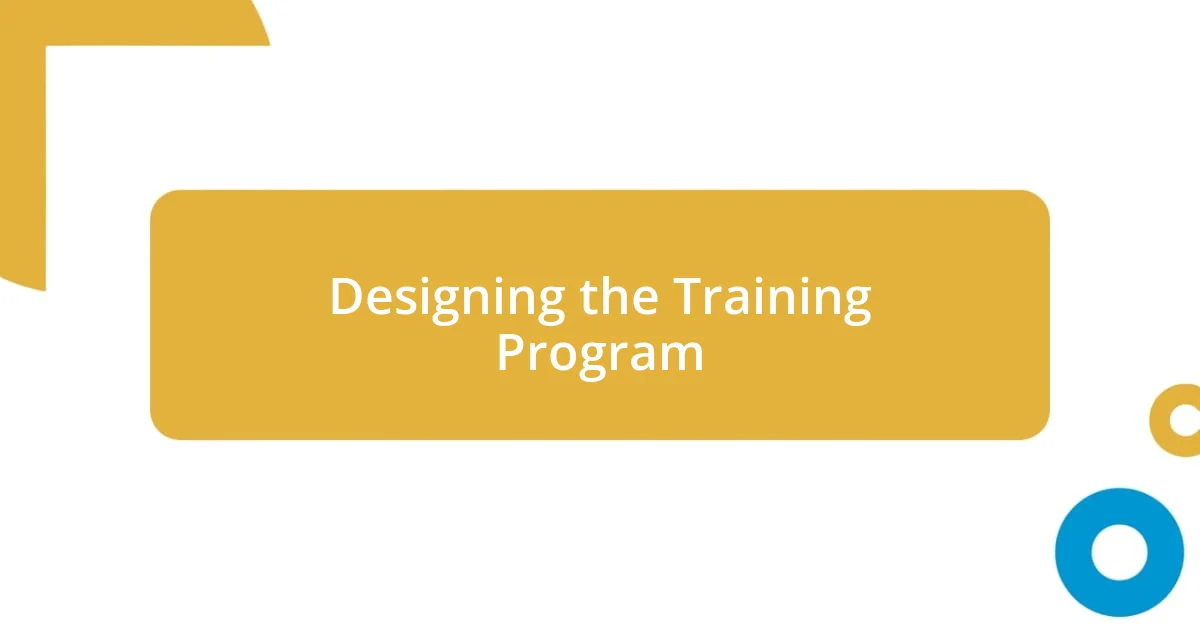
Designing the Training Program
Designing the training program is where the magic truly begins. In my experience, it’s essential to set clear objectives that align with both the organization’s values and legal requirements. I still remember brainstorming with my team on the best way to convey complex regulatory information while making it relatable enough for everyone. This collaborative process not only enhanced the training’s effectiveness but also fostered a sense of ownership among us.
To design a successful training program, consider the following key elements:
- Target Audience: Understand the diverse roles within the organization to tailor the content effectively.
- Modules & Structure: Break down the training into manageable modules that address specific topics.
- Interactive Methods: Utilize hands-on activities and discussions to keep participants engaged and foster dialogue.
- Real-life Scenarios: Incorporate case studies and examples that resonate with employees’ everyday experiences.
- Feedback Mechanisms: Establish ways for participants to share their thoughts post-training to continually improve the program.
Each aspect I implemented in the training genuinely reflected our collective needs. When I changed the approach based on feedback, I noticed participants becoming more involved. The engagement turn was incredible; it sparked enthusiasm and a willingness to learn that I hadn’t seen before. It truly demonstrated how thoughtfully designing a program could pivot compliance from a mere obligation to an essential part of our culture.
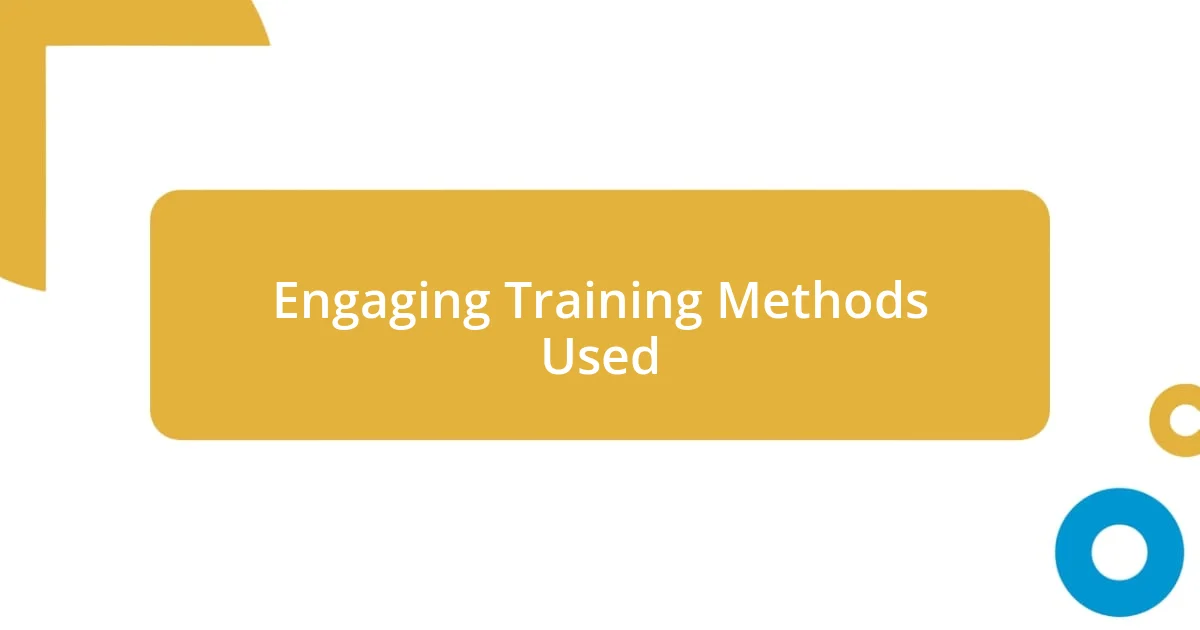
Engaging Training Methods Used
Incorporating interactive elements into compliance training was a key strategy I employed. One approach that worked wonders involved gamifying the learning process. We used role-playing scenarios, where employees acted out potential ethical dilemmas they might face on the job. The energy in the room during these activities was palpable; I remember a colleague who initially seemed hesitant to participate but transformed into an enthusiastic contributor. Engaging in this hands-on method not only broke the ice but also allowed participants to think critically about compliance in a fun, relatable context.
I also found that including multimedia resources, such as videos and infographics, significantly enhanced engagement. One memorable session featured a powerful video illustrating the consequences of non-compliance through real-life examples. The way my colleagues leaned in, visibly moved by the stories shared, reaffirmed my belief in using emotionally charged content. These visual mediums can be transformative—after all, why stick to dry presentations when you can spark genuine reactions and discussions?
Lastly, I prioritized open dialogue. During our training sessions, I always reserved time for Q&A, which allowed team members to voice their concerns and clarify doubts. It’s fascinating how much participants opened up when they felt their opinions were valued. For instance, I recall a training where someone brought up an industry-specific concern they had been wrestling with. That discussion not only enriched the session but also reinforced our shared commitment to cultivating a supportive environment for compliance. Doesn’t it make you wonder how much more effective compliance training could be if everyone felt genuinely heard?
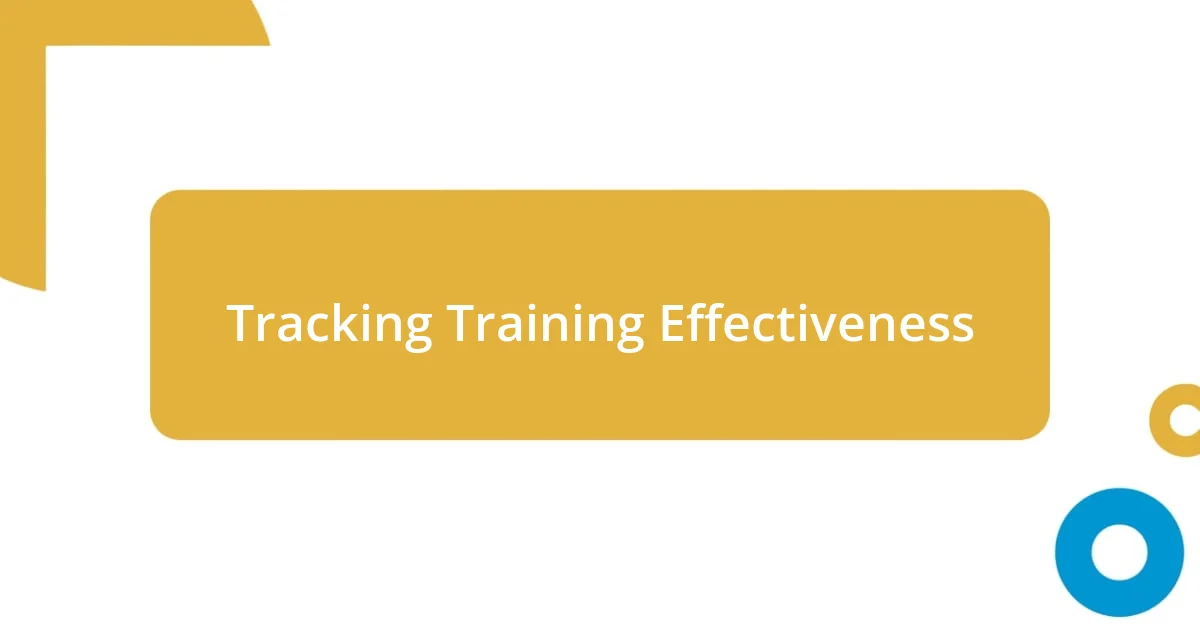
Tracking Training Effectiveness
Tracking the effectiveness of our training initiatives has always been a critical step for me. In one instance, I implemented pre- and post-training assessments to gauge knowledge retention. It was eye-opening to see participants’ scores improve significantly, which also reinforced the importance of the new concepts we introduced. This kind of measurable outcome not only offered tangible proof that the training worked, but it also motivated me to refine future sessions based on these insights.
I also conducted informal feedback sessions to understand participants’ perceptions and areas for improvement, which unexpectedly led to some of the most insightful discussions. I recall a session where an employee candidly shared how some of the scenarios we discussed really resonated with their daily challenges. This feedback helped me realize that training can be much more effective when participants connect their learning to real-life situations. It’s a reminder that tracking effectiveness isn’t just about metrics; it’s about understanding the human experience behind those numbers.
Additionally, I made sure to follow up several weeks after the training—not just to reinforce our learning objectives, but to see how the newfound knowledge was being applied on the job. One time, an employee reached out to share how they had navigated a tricky compliance situation using tools from our training. Hearing that made me feel validated, as it highlighted the actual impact of our efforts. It begs the question: How often do we stop to measure not just what we’ve taught, but how it’s truly transforming workplace behavior?
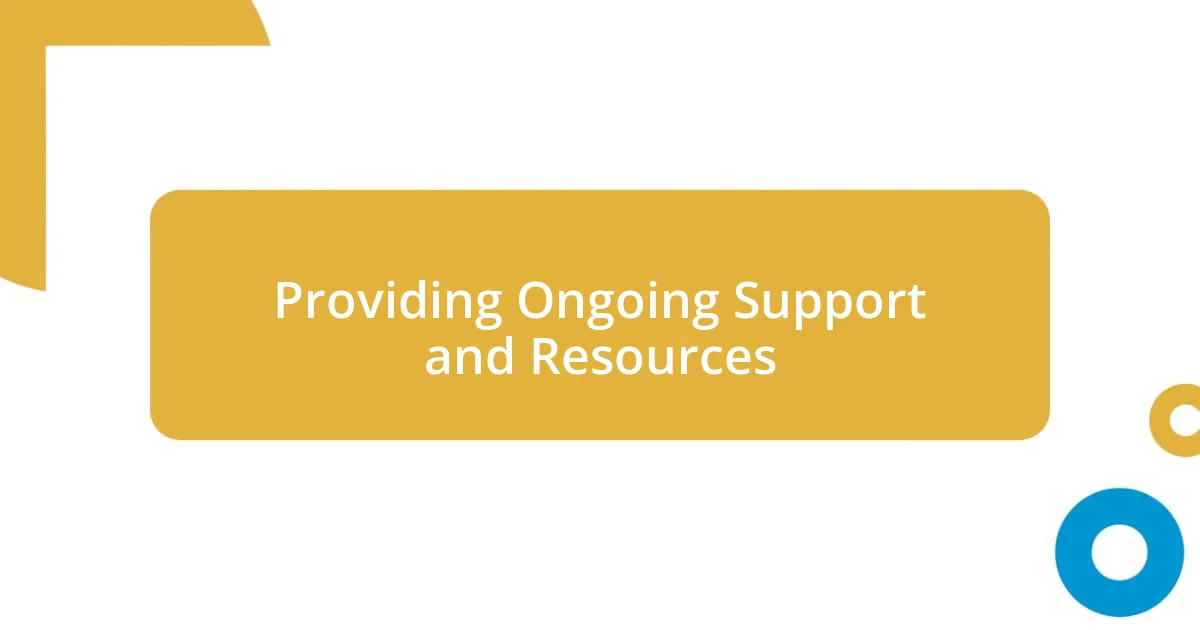
Providing Ongoing Support and Resources
Providing ongoing support and resources is essential for ensuring that compliance training has a lasting impact. After our initial sessions, I created a dedicated online platform where employees could access training materials, videos, and additional reading resources anytime. It was incredible to see how many colleagues returned to these materials, seeking clarification or diving deeper into specific topics. The enthusiasm they showed reinforced my belief that having easy access to resources fosters a culture of continuous learning.
I also established a mentorship program, pairing seasoned employees with newer team members to discuss compliance-related challenges. One memorable moment was when a junior staff member reached out to their mentor about a tricky situation involving vendor relations. The advice and guidance shared during those discussions not only helped resolve the issue but also created bonds that transformed how they approached compliance as a team. Isn’t it inspiring how relationships built on shared knowledge can empower individuals to face challenges head-on?
As part of my ongoing support strategy, I organized monthly “refresh” sessions aimed at reinforcing key concepts and sharing updates on regulations that affect our industry. During one of these sessions, I shared a recent case study that illustrated the consequences of non-compliance. The attentive expressions on my colleagues’ faces told me that they weren’t just hearing the information; they were absorbing it. This ongoing engagement encouraged everyone to reflect on our practices and inspired conversations about improvement. Does it not make you think about the value of continual engagement in fostering a responsible workplace?
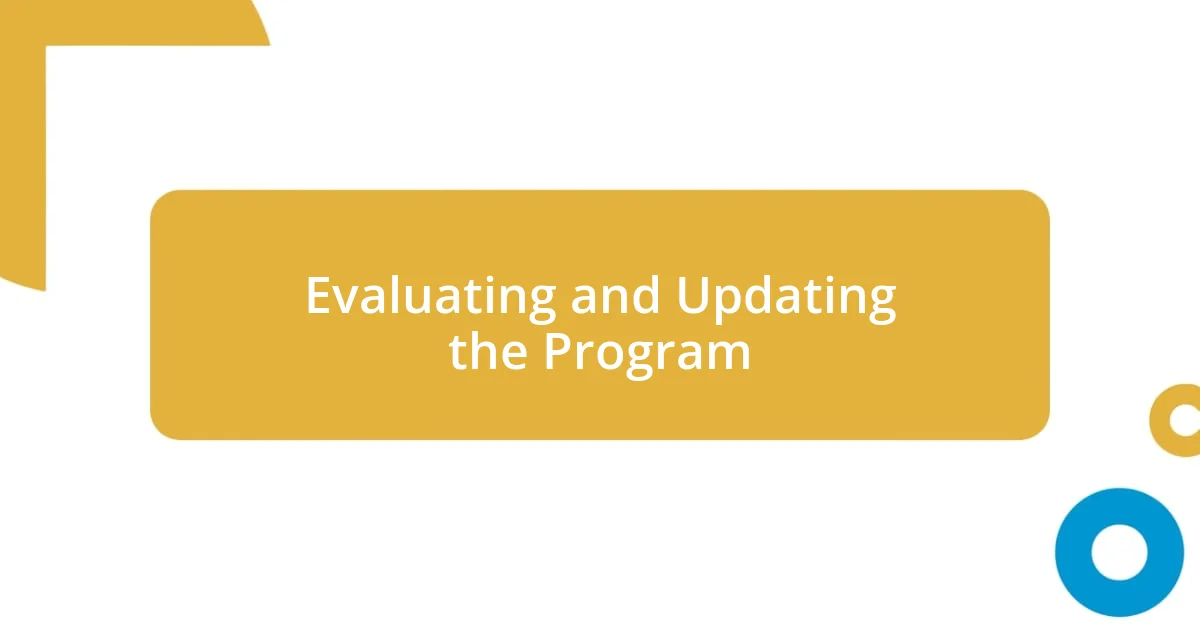
Evaluating and Updating the Program
Evaluating and updating the compliance training program should be a dynamic and iterative process, one that I found could not be overlooked. I remember a time when we conducted a comprehensive review of our training materials after a significant regulatory change. The insights gained from employee feedback highlighted not only the need for updates but also sparked ideas for new case studies relevant to the evolving landscape. This kind of proactive approach reinforced the idea that compliance isn’t static; it requires us to be constantly aware and responsive to changes.
While revisions are essential, I’ve learned that it’s equally important to involve participants in the evaluation process. After implementing a new training module, I sent out a survey asking for specific feedback on its effectiveness and relevance. The responses were candid, with some participants expressing confusion over certain terms we used. This taught me the value of clarity and the need to tailor our language to ensure everyone—regardless of their background—can grasp the materials fully. It’s fascinating how a simple survey can provide rich insights and encourage a culture of open communication.
Finally, I established a routine of revisiting and refreshing the program annually. During our last review session, I sat with key stakeholders to map out areas for improvement, and their enthusiasm was palpable. I could feel the collective ambition to elevate our training to meet the highest standards. This experience left me pondering: How often do we truly assess the tools we provide, ensuring they’re as effective and engaging as possible? The constant evolution of the program is what keeps it relevant—and vital.












